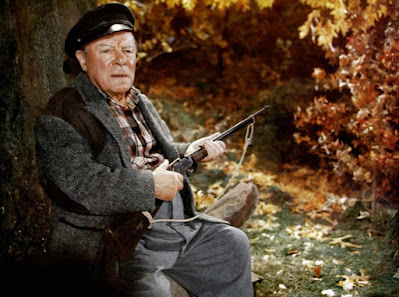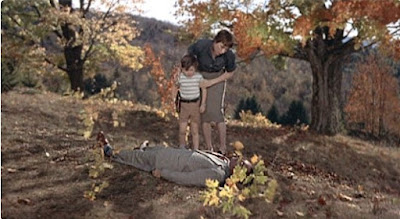 | |
|
Directed by: Alfred Hitchcock Music: Bernard Herrmann Starring: John Forsythe, Shirley MacLaine, Edmund Gwenn, Mildred Natwick, Mildred Dunnock, Jerry Mathers, Royal Dano |
"What's the trouble, Captain?"
The Criterion Channel is celebrating an Alfred Hitchcock month and while going through their collection, my husband made a list of the films he wanted to watch. I’d watched The Trouble With Harry many years ago, and so I picked that to watch. Not having watched it before, my husband agreed, especially since the principal filming for the film was in Vermont, a neighbouring state.
The film opens with an autumnal countryside, in the neighbourhood of the rural hamlet of Highwater. Captain Wiles (Edmund Gunn), a retired sea captain, is out with his rifle, hoping to pot a rabbit.
First, however, he takes a shot at the sign that says "No Tresspassers, No Hunting, No Poaching" posted by the deputy sheriff. Then, hearing a rustle in the bushes, he lets off a couple of other shots. Also wandering around the woods with his air gun at the same time is little Arnie (Jerry Mathers). Hearing the shot, Arnie, hesitantly sets off to investigate. And finds a very incongruous addition to a cheery, sunlit forest clearing.
He immediately runs off to tell his mother just as Captain Wiles comes up the hill. He has accounted for two of his bullets (the second one has perforated a beer can that someone has thrown away in the woods) and the third bullet seems to have found a home in this man’s brain. Captain Wiles is aghast. This was most unexpected. The man, a stranger too. The captain quickly checks the man’s pockets and finds an envelope addressed to a Harry Worp of 87 Maple Avenue, Massachusetts, Boston. That doesn’t tell Wiles much, so he decides that the best thing to do would be to conceal the body. But just as he picks the body up by the legs and begins to pull, he’s interrupted.
The newcomer is Miss Gravely (Mildred Natwick), who seems to take a strange dead body in her stride. She allays Captain Wiles’ fears about telling the police and invites him to visit her that afternoon (after he’s buried the body) for a cup of coffee and a blueberry muffin – and perhaps, some elderberry wine. Captain Wiles is charmed. She leaves, but the Captain is interrupted by the return of young Arnie, accompanied by his mother, Jennifer (Shirley MacLaine, in her debut).
Captain Wiles jumps into the bushes like a scared rabbit, and is at first shocked when Jennifer recognises the dead man, and then relieved when it becomes clear that Jennifer is very glad Harry is dead.
The hillside seems to be a very popular place that afternoon – as soon as Jennifer and Arnie leave, Dr Greenbow (Dwight Marfield) shows up. He’s the local doctor, a bit absent-minded, and presently, he’s got his nose stuck in a book.
He stumbles over the corpse’s leg, gets up, scrabbles around for his glasses, begs the corpse’s pardon, and goes his way. Then comes a tramp, who upon discovering the man is dead, swipes his rather natty shoes, leaving the corpse wearing a pair of startlingly bright blue and red socks.
By now, the captain, sick of the continued parade of visitors has dozed off under a tree.
The action now shifts back to the village general store, run by Mrs Wiggs (Mildred Dunnock), which doubles as the post office, the greengrocer’s, etc. Sam Marlowe (John Forsythe), a visiting artist who’s made Highwater his home for the summer, is trying to set Sam’s paintings to advantage.
She doesn’t think much of them, and indeed, hasn’t been able to sell any, but Sam is nonchalant. He’s very sure of his own genius. While he’s there, Miss Gravely comes in looking for a ‘man’s cup’. Sam, being inquisitive by nature, soon has her confessing that Captain Wiles is to visit her that afternoon. Much to her surprise, she’s soon bullied by Sam into having a makeover.
When that is completed to his satisfaction, he picks up his sketchbook and decides to take a ramble. What he does stumble upon is the dead body. So, he pulls out his charcoal stick and begins to sketch the man. [It’s amazing how little a dead body seems to bother anyone in this film!]
This is when the Captain wakes up. Soon, he’s confessing all. So Sam, who seems a rather cheery sort, decides to help the Captain hide the corpse in the bushes. And then he trots off to Jennifer’s to find out what she knows about it.
Soon, Sam is chatting up Jennifer, with whom he’s smitten at first sight. “Can I sketch you in the nude?” he asks her, to which she quips, “Some other time, Mr Marlowe.” But she does offer him lemonade, while Arnie trades him a dead rabbit, then borrows it back.
From Jennifer, Sam gets to know that the dead man is Jennifer’s brother-in-law, who married her when her first husband died and she was pregnant with Arnie. He had married her out of a sense of duty, and Jennifer had left him after the first night. He had been pursuing her, trying to persuade her to come back – he had even appeared at her doorstep this morning. She had hit him on the head with a milk bottle and sent him on his way.
Since that’s settled the ‘Who?’, Sam goes back up the hillside and helps Captain Wiles bury Harry.
“Facing West, so Harry can watch the setting sun.” But as they are resting, Sam mentions the dead rabbit. The captain is nonplussed – well, then, that accounts for his third bullet. So… who killed Harry? They dig him up again and discover that the man had died from what the police would call ‘a blow with a blunt instrument’. Hmm… they quickly bury him again.
They return to the village where Captain Wiles freshens up for his date. There, Miss Gravely has a startling confession to make. And Harry has to be dug up again.
The trouble with Harry is that he is dead. The trouble with Harry is that no one seems to care that he's dead. The trouble with Harry is that he just can’t stay buried. No one seems to care who killed Harry? And why?
No one, except Deputy Sherriff Calvin Wiggs (Royal Dano).
Based on a short story by Jack Trevor Story, "The Trouble With Harry" may not be considered one of Hitchcock’s best (it was one of the five "Lost Hitchcocks" for a while), but it is a charming dark comedy for all that. This would be the first film on which the director collaborated with composer Bernard Herman. The dialogues, especially between Jennifer and Sam are crackling, while the Captain gets some wonderful one-liners that are bound to make you laugh. The whole plot is a farce – no one, but no one, seems to care they have a dead man on their hands; nor his death on their conscience. The corpse is, in fact, a MacGuffin.
New England, in Autumn, is a wonderful sight, and the camera captures the beauty of the quaint countryside. Unfortunately, a lot of it is fake – coming to shoot in Vermont in September, the crew discovered that a storm had denuded the trees of their Fall foliage. According to reports, Hitchcock had tonnes of leaves shipped from the Vermont countryside and the crew spent ages painting them and sticking them on to the trees in a Los Angelos studio. Quite a few scenes were filmed in the studios with fake trees and fake foliage.
The Trouble With
Harry is a whimsical tale,
and subverts much of the usual ‘murder mystery’ tropes. But as Hitchcock himself said in an interview with Cahiers du Cinema (1956): "To my way of thinking, the characters in 'The Trouble With Harry' have
reactions which are absolutely normal and logical. It’s their peculiar
behaviour, free from affectation, from dissimulation, from worldly
concerns, from conformity, that makes us believe they cannot be real.
In other words, instead of the logic of the absurd, I prefer the
absurdity of logic." [As recalled in Hitchcock on Hitchcock, edited by Sidney Gottlieb.]
The Trouble With Harry does end rather abruptly, in that no one really seems bothered about the dead man, but if you don’t stop to think too much and want to watch an excellent ensemble cast run around a corpse that refuses to stay buried, it’s perfect Sunday afternoon fare.














No comments:
Post a Comment